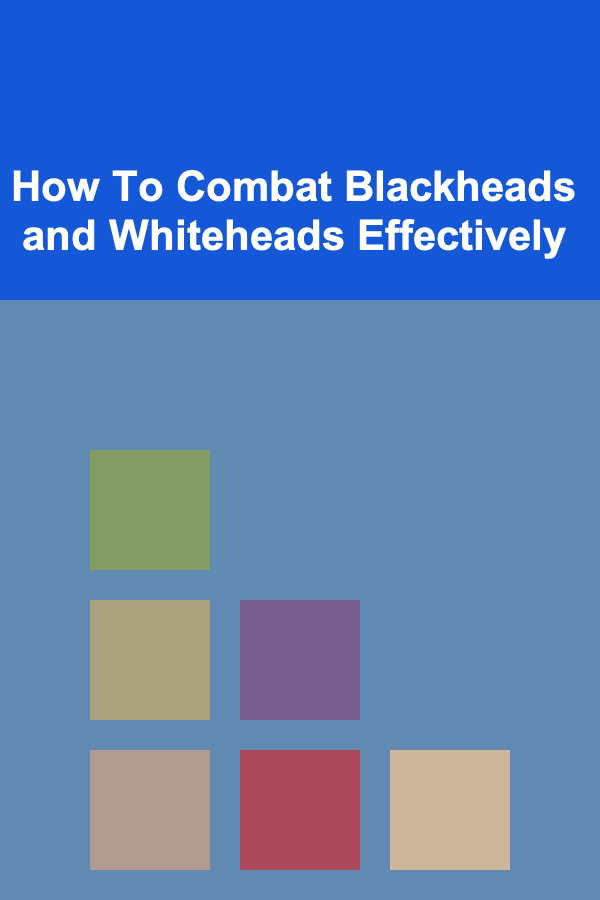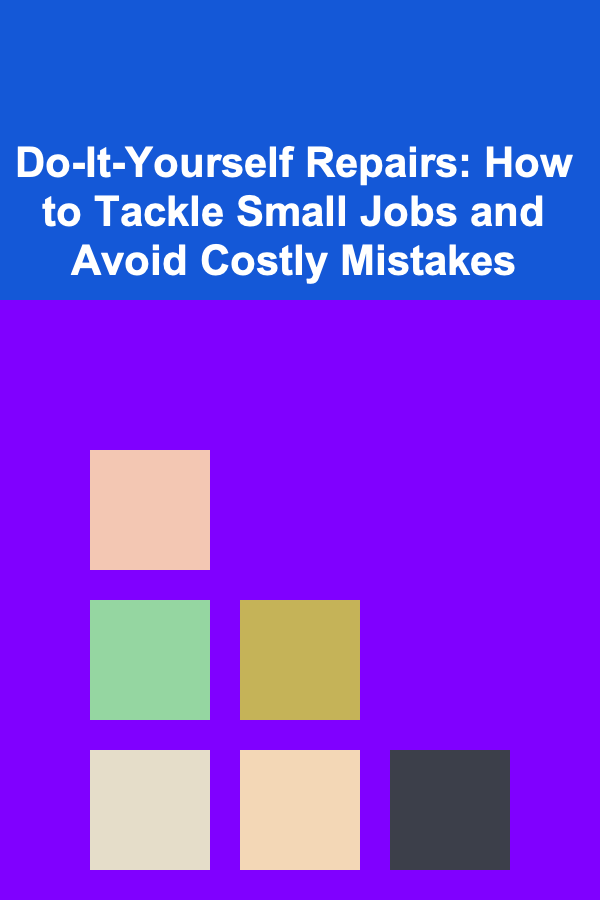
How To Combat Blackheads and Whiteheads Effectively
ebook include PDF & Audio bundle (Micro Guide)
$12.99$8.99
Limited Time Offer! Order within the next:

Blackheads and whiteheads, commonly referred to as comedones, are two of the most common forms of acne that many people face. While they are often a source of frustration, the good news is that with the right care, prevention strategies, and treatment options, you can effectively manage and reduce them. This article explores the causes, prevention techniques, and treatment options for blackheads and whiteheads, giving you the tools to combat these skin concerns confidently.
Understanding Blackheads and Whiteheads
Before we dive into how to combat these skin concerns, it's essential to understand what blackheads and whiteheads are and how they form.
What Are Blackheads?
Blackheads are a type of open comedo that forms when hair follicles become clogged with excess oil (sebum), dead skin cells, and debris. Unlike other types of acne, blackheads have an open surface. The dark color of blackheads is not caused by dirt but by the oxidation of the oils and skin cells inside the pore when exposed to air. Blackheads are typically found on the face, particularly on the nose, forehead, and chin, but they can also appear on the back and shoulders.
What Are Whiteheads?
Whiteheads, also known as closed comedones, are similar to blackheads, but they form when the hair follicle is clogged with oil and skin cells, and the pore remains closed. This results in small, flesh-colored bumps on the skin's surface. Whiteheads tend to appear in areas with more sebaceous glands, such as the face, neck, and chest. Unlike blackheads, whiteheads are not exposed to air, so they don't oxidize and turn black.
Causes of Blackheads and Whiteheads
Both blackheads and whiteheads occur due to the same underlying cause: the overproduction of oil combined with the accumulation of dead skin cells in hair follicles. Several factors can contribute to the development of these comedones:
- Excess Sebum Production: Hormonal changes during puberty, menstruation, pregnancy, or the use of birth control can lead to an increase in sebum production, which can clog pores.
- Dead Skin Cells: When the skin's natural exfoliation process slows down, dead skin cells can accumulate on the surface of the skin and contribute to clogged pores.
- Bacteria: While bacteria don't directly cause blackheads or whiteheads, an overgrowth of bacteria in clogged pores can contribute to inflammation and lead to other forms of acne, like pimples or cysts.
- Diet: Certain foods, particularly those high in refined sugars, dairy, and processed foods, have been linked to an increase in acne.
- Cosmetic Products: Some makeup and skincare products, especially those that are oil-based, can clog pores and exacerbate blackheads and whiteheads.
- Environmental Factors: Pollution, humidity, and sweating can all contribute to clogged pores and the development of comedones.
Prevention of Blackheads and Whiteheads
While it may not always be possible to completely avoid blackheads and whiteheads, there are several effective preventive measures that can help minimize their occurrence.
1. Maintain a Consistent Skincare Routine
Having a daily skincare routine that includes cleansing, exfoliating, and moisturizing is one of the most important ways to prevent blackheads and whiteheads. Here's how each step contributes to healthy skin:
- Cleansing: Use a gentle, non-comedogenic cleanser to remove excess oil, dirt, and makeup. Cleansing twice a day---morning and night---helps keep your pores clean and prevents buildup.
- Exfoliating: Exfoliation removes dead skin cells that can contribute to clogged pores. Use a chemical exfoliant like salicylic acid, which can penetrate deep into pores, or a gentle physical exfoliant. However, avoid over-exfoliating, as this can irritate the skin and increase oil production.
- Moisturizing: Keeping your skin hydrated helps regulate sebum production. Look for a lightweight, non-comedogenic moisturizer that won't clog your pores.
2. Use Oil-Free, Non-Comedogenic Products
If you're prone to blackheads and whiteheads, it's important to choose skincare and makeup products that are labeled "non-comedogenic" or "oil-free." These products are formulated to avoid clogging pores and can significantly reduce the likelihood of developing comedones.
3. Avoid Touching Your Face
Touching your face throughout the day can transfer oils, dirt, and bacteria from your hands to your face, increasing the chances of pore blockages. Try to avoid resting your face in your hands or picking at your skin, as this can lead to more blackheads and whiteheads and potentially cause scarring.
4. Maintain a Healthy Diet
Your diet plays a significant role in your skin's health. Although the relationship between food and acne is complex, studies suggest that certain foods may exacerbate acne, particularly refined sugars, dairy, and highly processed foods. On the other hand, eating a diet rich in fruits, vegetables, lean proteins, and healthy fats may help improve your skin's appearance.
5. Protect Your Skin from the Sun
Sun exposure can damage the skin and lead to an overproduction of oil, which can contribute to clogged pores. Use a broad-spectrum sunscreen with SPF 30 or higher every day, even when it's cloudy. Choose a non-comedogenic sunscreen that won't clog your pores.
Treatment Options for Blackheads and Whiteheads
If you already have blackheads and whiteheads, don't worry---there are many treatment options available to help reduce and eliminate them. Below are some of the most effective methods.
1. Over-the-Counter Treatments
There are several over-the-counter (OTC) treatments that can help combat blackheads and whiteheads. These products typically contain active ingredients like:
- Salicylic Acid: This beta-hydroxy acid (BHA) penetrates deep into pores and helps exfoliate the skin, removing dead skin cells and excess oil. Salicylic acid is particularly effective for treating blackheads and whiteheads.
- Benzoyl Peroxide: While more commonly used for treating pimples, benzoyl peroxide can also help reduce inflammation and kill bacteria in clogged pores, preventing blackheads and whiteheads from turning into more severe acne.
- Retinoids: Retinoids are derived from vitamin A and help increase cell turnover, preventing dead skin cells from accumulating in hair follicles. OTC retinoids like adapalene (Differin) are effective at treating both blackheads and whiteheads.
- Alpha Hydroxy Acids (AHAs): AHAs like glycolic acid help exfoliate the skin's surface, promoting the shedding of dead skin cells and preventing clogged pores.
2. Professional Extractions
If you have persistent blackheads or whiteheads that don't respond to at-home treatments, visiting a dermatologist for professional extractions might be an option. A dermatologist can safely remove blackheads and whiteheads using specialized tools, reducing the risk of scarring or infection that can occur when attempting extractions at home.
3. Chemical Peels
Chemical peels involve applying a solution to the skin that exfoliates the surface and helps clear clogged pores. A dermatologist can perform chemical peels using stronger acids like salicylic acid or glycolic acid, which are particularly effective for treating blackheads and whiteheads.
4. Laser and Light Therapies
Certain laser and light therapies can help reduce the size of pores, decrease sebum production, and kill acne-causing bacteria. These treatments are typically performed in a dermatologist's office and can be effective for more stubborn cases of acne.
5. Prescription Treatments
For more severe cases of blackheads and whiteheads, your dermatologist may recommend prescription-strength treatments, including:
- Oral Medications: If your blackheads and whiteheads are related to hormonal imbalances, oral medications like birth control pills or anti-androgen drugs may help reduce sebum production.
- Topical Retinoids: Stronger retinoids like tretinoin (Retin-A) are often prescribed to help clear clogged pores and prevent the formation of comedones.
- Antibiotics: In some cases, oral or topical antibiotics like clindamycin or tetracycline may be prescribed to reduce inflammation and prevent bacterial growth within pores.
Natural Remedies for Blackheads and Whiteheads
If you prefer to try natural treatments before turning to over-the-counter or prescription options, here are a few remedies that may help:
1. Tea Tree Oil
Tea tree oil has antimicrobial and anti-inflammatory properties, making it effective in reducing acne. Dilute a few drops of tea tree oil with a carrier oil (such as coconut or jojoba oil) and apply it directly to the affected areas.
2. Honey and Cinnamon Mask
Honey has antibacterial properties, and cinnamon is known for its anti-inflammatory effects. A mixture of honey and cinnamon applied to the skin may help reduce blackheads and whiteheads by fighting bacteria and inflammation.
3. Green Tea
Green tea is rich in antioxidants and can help reduce inflammation in the skin. Applying cooled green tea bags or using green tea-based skincare products can help manage acne and prevent future breakouts.
4. Aloe Vera
Aloe vera is known for its soothing properties and can help reduce inflammation and redness associated with blackheads and whiteheads. Applying aloe vera gel to the skin can help keep it hydrated and reduce irritation.
Conclusion
While blackheads and whiteheads are common skin concerns, they don't have to control your life. By understanding their causes, implementing a consistent skincare routine, and choosing the right treatment options, you can effectively manage and prevent these blemishes. Whether you prefer over-the-counter treatments, professional help, or natural remedies, there are plenty of strategies available to combat blackheads and whiteheads and achieve clear, healthy skin.

Do-It-Yourself Repairs: How to Tackle Small Jobs and Avoid Costly Mistakes
Read More
How to Get Started with Cryptocurrency Investments
Read More
The Ultimate Guide to Thrifty Gift-Wrapping Ideas for Every Occasion
Read More
Top Tips for Effectively Utilizing Digital Banking and Budgeting Tools
Read More
How to Sketch Anything You See: Observational Drawing
Read More
Understanding Applied Kinesiology: A Deep Dive
Read MoreOther Products

Do-It-Yourself Repairs: How to Tackle Small Jobs and Avoid Costly Mistakes
Read More
How to Get Started with Cryptocurrency Investments
Read More
The Ultimate Guide to Thrifty Gift-Wrapping Ideas for Every Occasion
Read More
Top Tips for Effectively Utilizing Digital Banking and Budgeting Tools
Read More
How to Sketch Anything You See: Observational Drawing
Read More